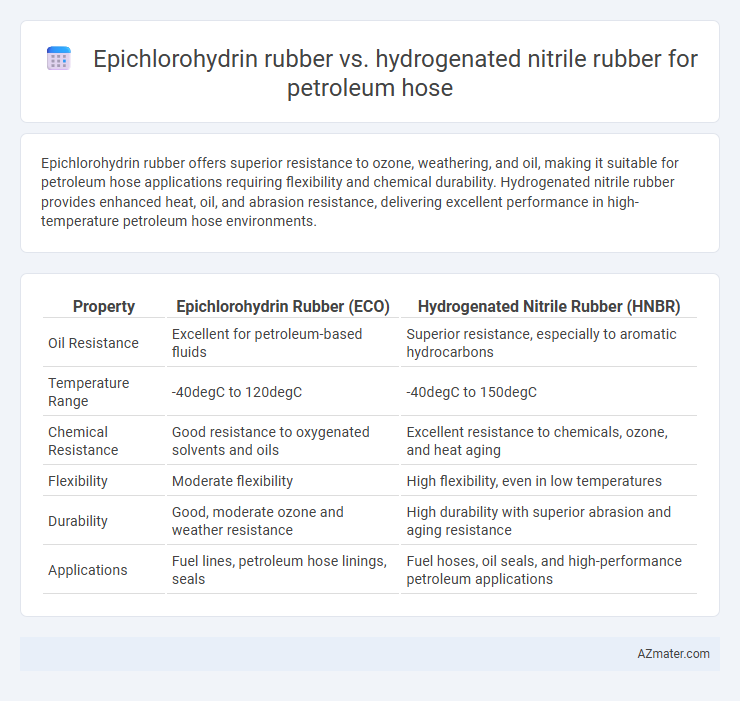Epichlorohydrin rubber offers superior resistance to ozone, weathering, and oil, making it suitable for petroleum hose applications requiring flexibility and chemical durability. Hydrogenated nitrile rubber provides enhanced heat, oil, and abrasion resistance, delivering excellent performance in high-temperature petroleum hose environments.
Table of Comparison
| Property | Epichlorohydrin Rubber (ECO) | Hydrogenated Nitrile Rubber (HNBR) |
|---|---|---|
| Oil Resistance | Excellent for petroleum-based fluids | Superior resistance, especially to aromatic hydrocarbons |
| Temperature Range | -40degC to 120degC | -40degC to 150degC |
| Chemical Resistance | Good resistance to oxygenated solvents and oils | Excellent resistance to chemicals, ozone, and heat aging |
| Flexibility | Moderate flexibility | High flexibility, even in low temperatures |
| Durability | Good, moderate ozone and weather resistance | High durability with superior abrasion and aging resistance |
| Applications | Fuel lines, petroleum hose linings, seals | Fuel hoses, oil seals, and high-performance petroleum applications |
Introduction to Epichlorohydrin Rubber and Hydrogenated Nitrile Rubber
Epichlorohydrin rubber (ECO) is renowned for its excellent resistance to petroleum oils, weathering, and ozone, making it ideal for petroleum hose applications subjected to harsh environmental conditions. Hydrogenated nitrile rubber (HNBR) offers superior thermal stability, chemical resistance, and mechanical strength, providing enhanced durability in high-temperature petroleum transfer hoses. Both elastomers deliver critical performance characteristics, with ECO excelling in ozone and oil resistance while HNBR outperforms in heat and abrasion resistance, influencing material selection based on specific petroleum hose operating environments.
Key Properties of Epichlorohydrin Rubber (ECO)
Epichlorohydrin rubber (ECO) offers excellent resistance to ozone, weathering, and petroleum oils, making it suitable for demanding petroleum hose applications. Its key properties include superior hydrocarbon and chemical resistance, low gas permeability, and good flexibility at low temperatures. Compared to hydrogenated nitrile rubber (HNBR), ECO provides better resistance to ozone and aging, enhancing hose durability in harsh environments.
Key Properties of Hydrogenated Nitrile Rubber (HNBR)
Hydrogenated Nitrile Rubber (HNBR) offers excellent resistance to heat, oil, and chemicals, making it highly suitable for petroleum hose applications where durability under harsh conditions is critical. Its superior tensile strength and abrasion resistance ensure long service life and reliability in dynamic, high-pressure environments. HNBR also demonstrates remarkable resistance to ozone and weathering, outperforming Epichlorohydrin rubber in maintaining flexibility and performance over extended operational periods.
Resistance to Petroleum and Oil-based Fluids
Epichlorohydrin rubber offers excellent resistance to petroleum and oil-based fluids, making it highly suitable for petroleum hose applications requiring durable performance under exposure to fuels and lubricants. Hydrogenated nitrile rubber (HNBR) provides superior resistance to a wider range of hydrocarbons, including aggressive petroleum products, with enhanced thermal stability and ozone resistance that extends hose lifespan. Both elastomers exhibit strong oil resistance, but HNBR's superior mechanical strength and chemical resistance make it the preferred choice for demanding petroleum hose environments.
Temperature Performance Comparison
Epichlorohydrin rubber offers excellent resistance to ozone, weathering, and hydrocarbon oils with an effective operating temperature range of approximately -40degC to 120degC, making it suitable for moderate temperature applications in petroleum hoses. Hydrogenated nitrile rubber (HNBR), however, provides superior high-temperature performance, withstanding continuous exposure up to 150degC and short-term peaks near 165degC, along with enhanced resistance to heat aging and chemical degradation. This makes HNBR the preferred choice for petroleum hoses requiring higher temperature durability and extended service life under harsh thermal conditions.
Mechanical Strength and Flexibility
Epichlorohydrin rubber offers superior mechanical strength with enhanced abrasion and oil resistance, making it ideal for demanding petroleum hose applications requiring durability under high stress. Hydrogenated nitrile rubber (HNBR) provides exceptional flexibility and resilience at varying temperatures while maintaining excellent resistance to hydrocarbons and chemical degradation. Petroleum hoses made from HNBR exhibit longer service life in dynamic conditions due to their balance of flexibility and mechanical robustness.
Ozone and Weathering Resistance
Epichlorohydrin rubber offers excellent ozone and weathering resistance, making it highly suitable for petroleum hose applications exposed to harsh environmental conditions. Hydrogenated nitrile rubber (HNBR) also provides strong resistance to ozone degradation but surpasses epichlorohydrin in overall durability and heat aging properties. Both elastomers deliver reliable performance, yet HNBR's enhanced resistance to weathering extends the service life of petroleum hoses in demanding outdoor environments.
Cost and Availability Considerations
Epichlorohydrin rubber (ECO) generally offers a lower cost solution compared to hydrogenated nitrile rubber (HNBR) for petroleum hoses due to simpler manufacturing processes and more abundant raw materials. Availability of ECO is widespread in regions with established chemical industries, making it easier to source and favoring budget-sensitive projects. HNBR, while more expensive, provides superior oil resistance and durability, but its higher price and limited availability can restrict its use to specialized applications with stringent performance requirements.
Typical Applications in Petroleum Hose
Epichlorohydrin rubber exhibits excellent resistance to petroleum oils, fuels, and chemicals, making it ideal for petroleum hose linings in fuel transfer and oilfield applications where ozone and weather resistance are essential. Hydrogenated nitrile rubber (HNBR) offers superior thermal stability and resistance to a wide range of hydrocarbons, making it suitable for high-temperature petroleum hose applications such as crude oil and chemical transfer in demanding environments. Both materials provide robust performance in petroleum hoses, with Epichlorohydrin favored for chemical resistance and HNBR preferred for enhanced heat and abrasion resistance.
Choosing the Right Material for Petroleum Hose: ECO vs HNBR
Epichlorohydrin rubber (ECO) offers excellent resistance to petroleum oils, ozone, and weathering, making it a reliable choice for petroleum hose applications requiring flexibility and durability in harsh environments. Hydrogenated nitrile rubber (HNBR) provides superior chemical resistance, heat tolerance up to 150degC, and enhanced abrasion resistance, ideal for high-pressure petroleum transfer systems demanding long-term performance. Selecting between ECO and HNBR depends on operating temperature ranges, chemical exposure, and mechanical stress, with HNBR favored for high-temperature, high-abrasion applications while ECO suits moderate temperatures and weather resistance needs.

Infographic: Epichlorohydrin rubber vs Hydrogenated nitrile rubber for Petroleum hose
 azmater.com
azmater.com